Selecting the perfect sofa represents one of the most significant furniture investments you’ll make for your home, serving as both the centerpiece of your living space and the foundation for countless hours of relaxation, entertainment, and family gatherings. The right sofa choice can transform your living room into a welcoming sanctuary that reflects your personal style while providing years of comfort and functionality. However, with the overwhelming array of styles, materials, sizes, and price points available in today’s furniture market, making an informed decision requires understanding the complex interplay of design aesthetics, comfort engineering, construction quality, and long-term durability considerations.
The modern sofa market offers unprecedented variety, from traditional designs that have remained popular for centuries to cutting-edge contemporary styles that push the boundaries of both form and function. This diversity, while providing excellent opportunities to find pieces that perfectly match your needs and preferences, also creates challenges in navigating the numerous options and understanding the trade-offs between different choices. The key to successful sofa selection lies in developing a systematic approach that considers your lifestyle requirements, space constraints, aesthetic preferences, and budget limitations while understanding how different design and construction choices affect both immediate satisfaction and long-term value.
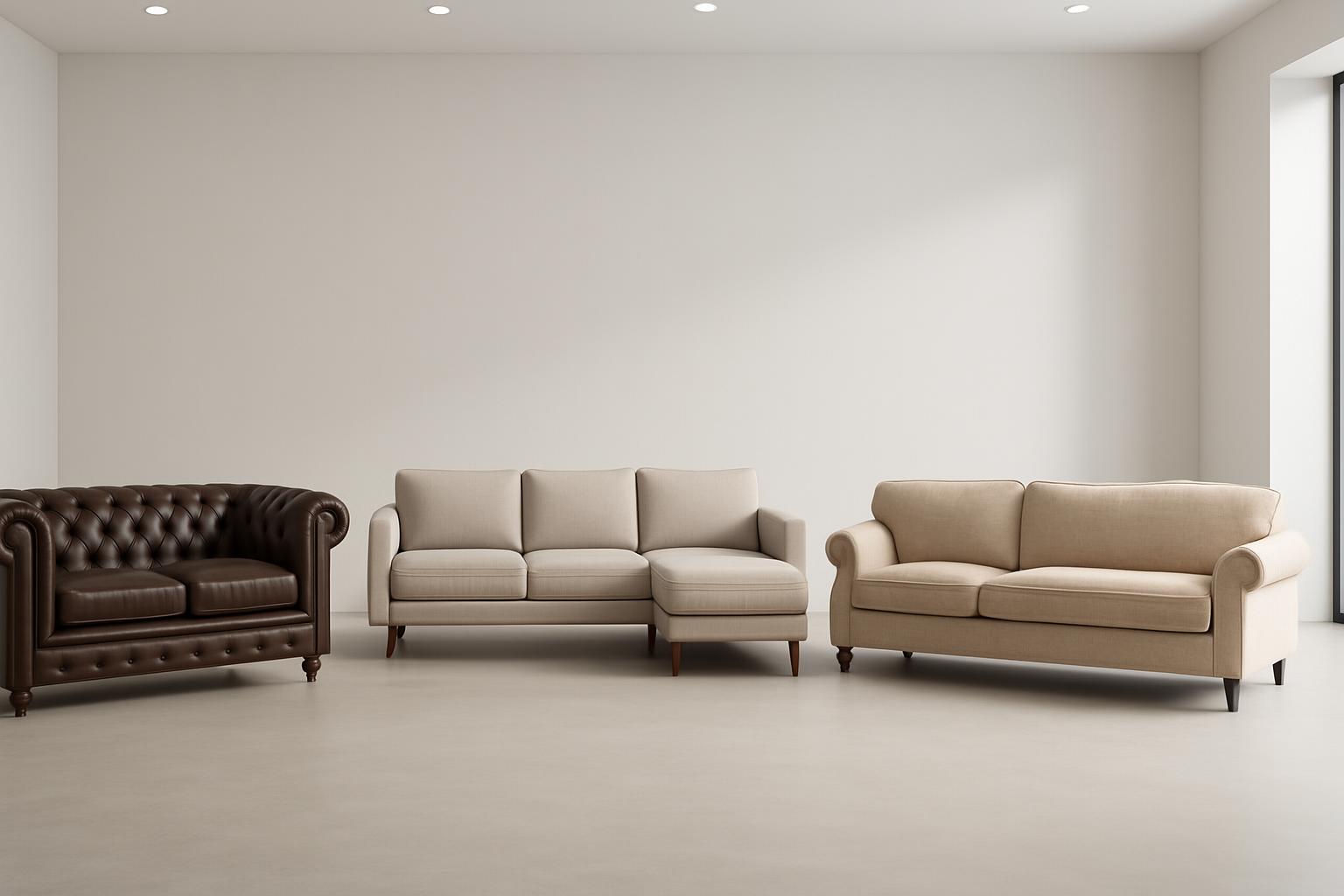
Understanding the relationship between style, comfort, and durability helps ensure that your sofa choice will continue to meet your needs and maintain its appeal throughout its lifespan. A sofa that looks beautiful in the showroom but proves uncomfortable for daily use, or one that provides excellent initial comfort but shows significant wear after just a few years, represents a poor investment regardless of its initial cost. The most successful sofa purchases are those that achieve the optimal balance of aesthetic appeal, comfort performance, and construction quality appropriate for your specific situation and usage patterns.
The investment nature of sofa purchases makes thorough research and careful consideration particularly important, as most people expect their sofas to serve them well for many years. Unlike smaller furniture pieces or decorative accessories that can be easily replaced as tastes change or wear occurs, sofas typically represent both significant financial commitments and central elements of room design that influence many other decorating decisions. Understanding how to evaluate and compare different options ensures that your investment will provide satisfaction and value throughout its intended lifespan.
Understanding Sofa Styles and Their Characteristics
The world of sofa design encompasses a rich variety of styles, each with distinct characteristics that reflect different design philosophies, historical periods, and functional approaches to seating furniture. Understanding these style categories and their defining features provides the foundation for making informed choices that align with your aesthetic preferences and complement your existing decor while meeting your functional requirements.
Traditional sofa styles draw inspiration from classical furniture design periods and emphasize timeless elegance, refined proportions, and sophisticated detailing that has proven appealing across generations. These designs typically feature more formal appearances with carefully crafted elements like rolled arms, button tufting, nail head trim, and turned legs that create visual interest and convey a sense of established quality and craftsmanship. Traditional sofas work particularly well in formal living rooms, classic home designs, and spaces where creating a sense of elegance and sophistication is a priority.
The Chesterfield sofa represents perhaps the most iconic traditional design, instantly recognizable by its deep button tufting, rolled arms that are the same height as the back, and typically leather upholstery that emphasizes the classic British heritage of this style. Originally designed in the 18th century, Chesterfield sofas have maintained their popularity due to their distinctive appearance and the sense of refined luxury they bring to any space. Modern interpretations of the Chesterfield design often incorporate contemporary materials and proportions while maintaining the essential design elements that make this style so recognizable and appealing.
English roll-arm sofas feature the characteristic rolled arms that curve gracefully from the seat to create a continuous, flowing line that emphasizes comfort and traditional craftsmanship. These designs typically include loose back cushions, welted seams, and proportions that prioritize comfort while maintaining elegant appearances. The English roll-arm style works particularly well in family rooms and casual living spaces where comfort is paramount but traditional styling is desired.
Contemporary sofa styles embrace clean lines, minimal ornamentation, and geometric forms that reflect modern design sensibilities and lifestyle preferences. These designs typically feature straight arms, simple silhouettes, and emphasis on proportion and material quality rather than decorative details. Contemporary sofas work well in modern homes, minimalist interiors, and spaces where creating a sense of openness and simplicity is desired.
Mid-century modern sofas draw inspiration from the design movement of the 1950s and 1960s, featuring characteristic elements like tapered legs, low profiles, and clean geometric lines that create distinctive retro appeal. These designs often incorporate interesting angles, contrasting materials, and bold proportions that make them focal points in room designs. Mid-century modern sofas have experienced renewed popularity in recent years as homeowners appreciate their timeless appeal and the way they bridge traditional and contemporary design sensibilities.
Sectional sofas represent a functional approach to seating that prioritizes versatility and space efficiency over traditional styling conventions. These modular designs can be configured in various arrangements to fit different room layouts and accommodate varying numbers of people, making them particularly popular in family rooms, entertainment spaces, and open-plan homes. Modern sectional designs range from simple L-shaped configurations to complex modular systems that can be reconfigured as needs change.
Transitional sofa styles blend elements from both traditional and contemporary design approaches, creating pieces that feel current while maintaining timeless appeal. These designs typically feature simplified traditional elements, updated proportions, and neutral styling that works well with various decorating approaches. Transitional sofas appeal to homeowners who appreciate classic design principles but prefer cleaner, more streamlined appearances than fully traditional styles provide.
The scale and proportion of different sofa styles significantly affect how they work in various room sizes and layouts, with some styles being better suited to larger spaces while others work well in more compact environments. Understanding these relationships helps ensure that your style choice will work well in your specific space and create the visual impact you desire.
Material Considerations: Fabric vs. Leather
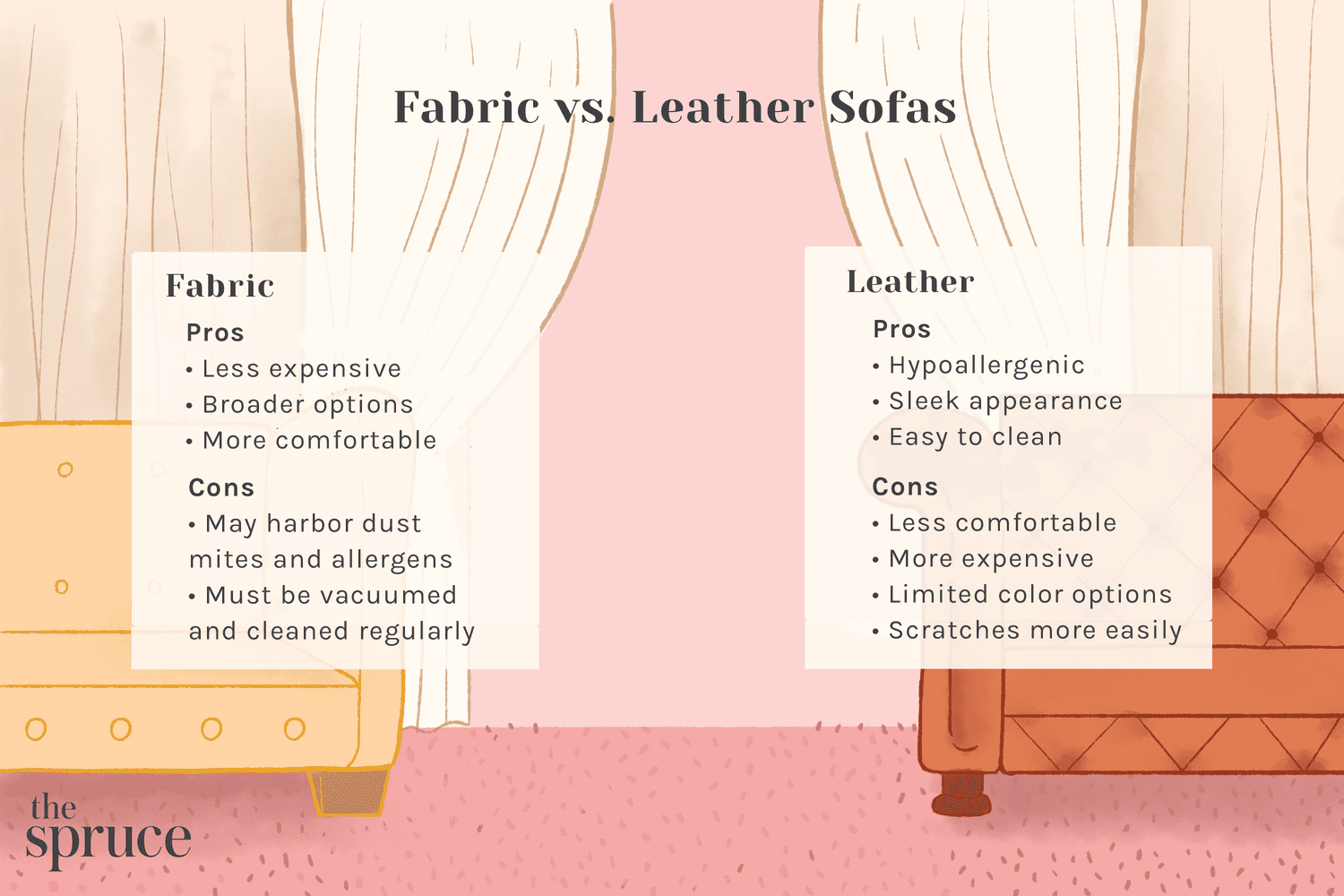
The choice between fabric and leather upholstery represents one of the most fundamental decisions in sofa selection, affecting not only the appearance and feel of your furniture but also its maintenance requirements, durability characteristics, and long-term performance. Each material category offers distinct advantages and considerations that make them more or less suitable for different lifestyles, usage patterns, and aesthetic preferences.
Fabric upholstery provides virtually unlimited options in terms of colors, patterns, textures, and performance characteristics, allowing for precise matching to existing decor and personal preferences. The variety available in fabric options means that you can find materials that range from delicate, decorative textiles suitable for formal living rooms to heavy-duty performance fabrics designed to withstand intensive family use. This flexibility makes fabric an excellent choice for homeowners who want specific colors or patterns, need to coordinate with existing decor, or prefer the softer, more casual feel that fabric typically provides.
Natural fiber fabrics like cotton, linen, and wool offer excellent breathability, comfortable feel, and often superior dyeing characteristics that create rich, lasting colors. Cotton fabrics range from casual canvas and denim to sophisticated velvets and brocades, providing options for every style preference and usage requirement. Linen offers a relaxed, casual appearance with excellent breathability but may require more maintenance to keep looking fresh. Wool fabrics provide excellent durability and natural stain resistance while offering sophisticated appearances and comfortable feel.
Synthetic fabrics including polyester, nylon, and acrylic blends often provide superior durability, stain resistance, and color retention compared to natural fibers while offering cost advantages and easier maintenance. Modern synthetic fabrics have overcome many of the comfort and appearance limitations of earlier versions, with many high-quality synthetic options being virtually indistinguishable from natural fibers in appearance and feel. Performance fabrics specifically designed for furniture use often incorporate advanced treatments for stain resistance, fade resistance, and easy cleaning.
Blended fabrics combine natural and synthetic fibers to achieve optimal balances of comfort, durability, and maintenance characteristics. These blends often provide the best aspects of both fiber types while minimizing their individual limitations. Common blends include cotton-polyester combinations that offer cotton’s comfort with polyester’s durability, and wool-nylon blends that provide wool’s luxury feel with enhanced wear resistance.
Leather upholstery offers a completely different set of characteristics, providing distinctive appearance, unique aging properties, and specific maintenance requirements that appeal to many homeowners. Quality leather develops character over time, becoming softer and more comfortable with use while developing a patina that many people find appealing. Leather also offers excellent durability when properly cared for, with high-quality leather sofas often lasting decades with appropriate maintenance.
Top-grain leather represents the highest quality option, using the outer layer of the hide that retains the natural grain pattern and provides the best combination of durability, appearance, and aging characteristics. Full-grain leather, which uses the complete thickness of the hide, offers maximum durability and develops the most attractive patina over time. These premium leather types command higher prices but provide superior long-term value for homeowners who appreciate leather’s unique characteristics.
Corrected-grain leather undergoes surface treatments to remove imperfections and create uniform appearance, often with embossed grain patterns that provide consistent texture. While not as premium as top-grain options, corrected-grain leather offers good durability and appearance at more accessible price points. Split leather, made from the lower layers of the hide, provides leather appearance at budget-friendly prices but with reduced durability and aging characteristics.
Leather care requirements include regular cleaning with appropriate products, conditioning to maintain suppleness, and protection from excessive heat and direct sunlight that can cause cracking and fading. However, leather’s natural properties make it resistant to many stains and odors that can permanently affect fabric upholstery. Understanding these maintenance requirements helps determine whether leather’s benefits align with your lifestyle and maintenance preferences.
Climate considerations affect both fabric and leather performance, with leather being particularly sensitive to humidity extremes that can cause cracking or excessive softening. Fabric choices may need to consider factors like humidity, sunlight exposure, and temperature variations that affect fading, shrinkage, and general appearance retention. Understanding your local climate conditions helps inform material choices that will perform well in your specific environment.
The tactile experience of different materials significantly affects daily comfort and satisfaction, with some people strongly preferring the warmth and softness of fabric while others appreciate leather’s smooth, cool feel and distinctive character. Personal preferences in this area often override other considerations, making it important to experience different materials firsthand before making final decisions.
Comfort Engineering: Cushions, Support, and Ergonomics
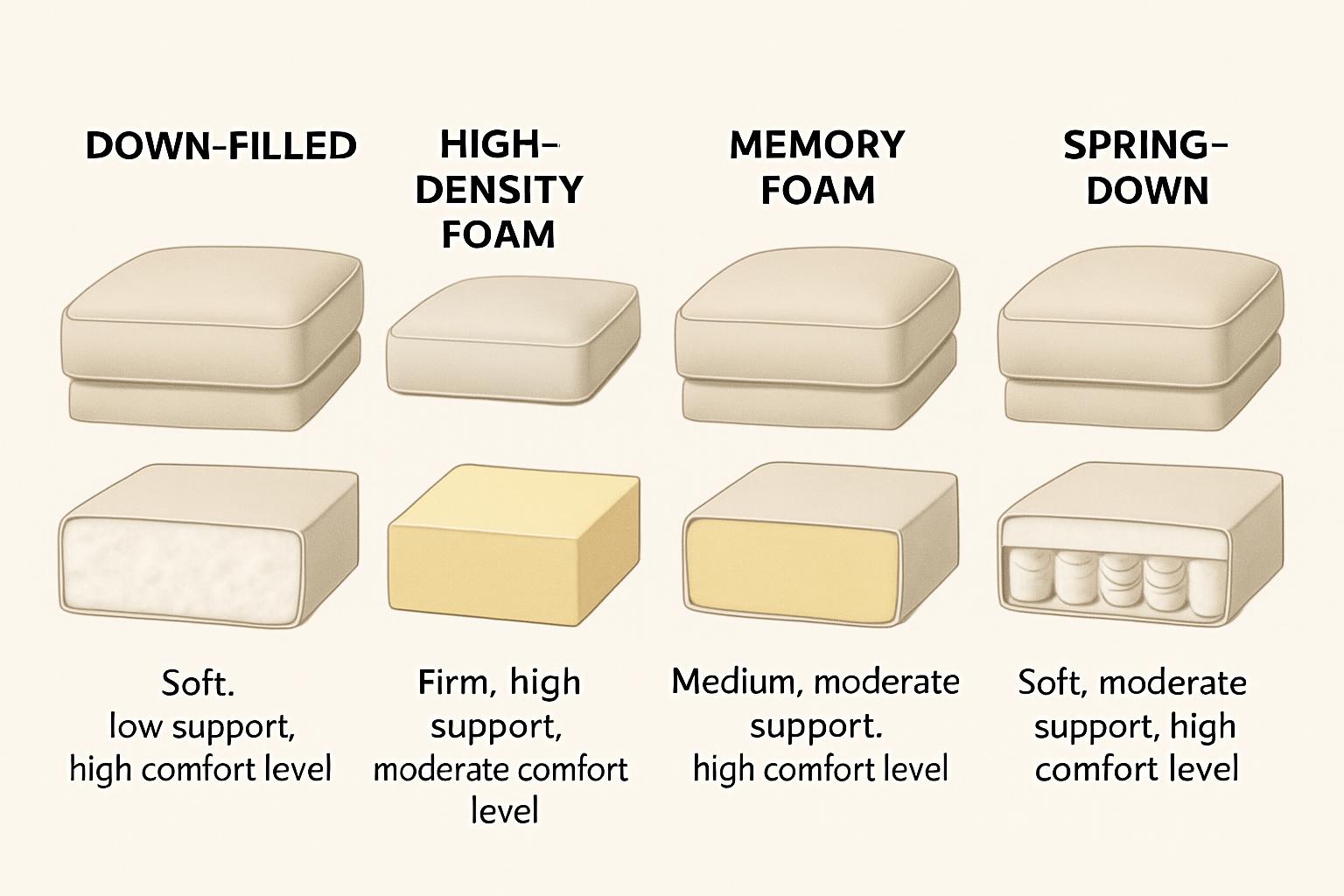
The comfort performance of a sofa depends on sophisticated engineering that balances support, softness, durability, and ergonomic considerations to create seating that remains comfortable throughout extended use periods. Understanding the various components that contribute to comfort helps you evaluate different options and choose sofas that will meet your specific comfort preferences and usage patterns over the long term.
Cushion construction represents the most critical factor in determining comfort characteristics, with different filling materials and construction methods producing dramatically different feel and performance. The choice of cushion filling affects not only initial comfort but also how the cushions maintain their shape and support over time, making this one of the most important considerations in sofa selection.
Down-filled cushions provide the ultimate in soft, luxurious comfort, conforming to body contours and creating a feeling of sinking into the seating. High-quality down cushions use duck or goose down that provides excellent loft and recovery, though they require regular fluffing to maintain their shape and appearance. Down cushions work best for people who prefer very soft seating and don’t mind the maintenance requirements, but they may not provide adequate support for those who need firmer seating or have back problems.
Down-alternative fills use synthetic materials to simulate down’s softness while providing easier maintenance and hypoallergenic properties. These fills often combine different synthetic fibers to achieve specific comfort characteristics while avoiding down’s tendency to compress permanently over time. Quality down-alternative cushions can provide excellent comfort while being more practical for everyday use and easier to maintain than natural down.
High-density foam cushions provide firm, consistent support that maintains its shape well over time while offering good durability and value. The density and firmness of foam can be varied to create different comfort levels, from soft and plush to firm and supportive. Quality foam cushions often incorporate multiple layers with different densities to provide both surface comfort and underlying support, creating seating that feels comfortable initially while providing good long-term support.
Memory foam cushions conform to body contours while providing excellent support, making them particularly appealing for people with back problems or those who spend long periods sitting. Memory foam responds to body heat and pressure to create customized support that reduces pressure points while maintaining proper spinal alignment. However, memory foam can feel warm and may respond slowly to position changes, making it less suitable for people who prefer more responsive seating.
Spring-down combinations use coil springs for underlying support with down or down-alternative layers for surface comfort, creating cushions that provide both firm support and soft feel. These hybrid constructions often provide the best balance of comfort and support while maintaining good shape retention over time. The spring systems provide consistent support that doesn’t compress like foam, while the down layers create comfortable surface feel.
Seat depth significantly affects comfort for different body types and sitting preferences, with deeper seats providing more relaxed, lounging positions while shallower seats work better for more upright sitting and easier entry and exit. Standard seat depths range from about 20 to 24 inches, with deeper options available for those who prefer more relaxed positioning. Understanding your preferred sitting style and body proportions helps determine the optimal seat depth for your comfort.
Back support design affects both comfort and long-term spinal health, with different back angles, cushion configurations, and support levels creating different seating experiences. Sofas with more upright backs provide better support for activities like reading or conversation, while more reclined backs encourage relaxation and lounging. The height and shape of back cushions also affect how well the sofa supports different body types and sitting positions.
Arm height and style affect both comfort and the overall proportions of the sofa, with higher arms providing more support for resting arms and elbows while lower arms create more open, casual appearances. The width and padding of arms also affect comfort, particularly for people who like to rest against the arms or use them for additional support when getting up from the sofa.
Ergonomic considerations become particularly important for people who spend significant time on their sofas or have specific physical needs or limitations. Features like lumbar support, appropriate seat height for easy entry and exit, and proper proportions for different body types can significantly affect both comfort and long-term health. Understanding these factors helps ensure that your sofa choice will support your physical well-being as well as provide comfort.
Frame Construction and Durability Assessment
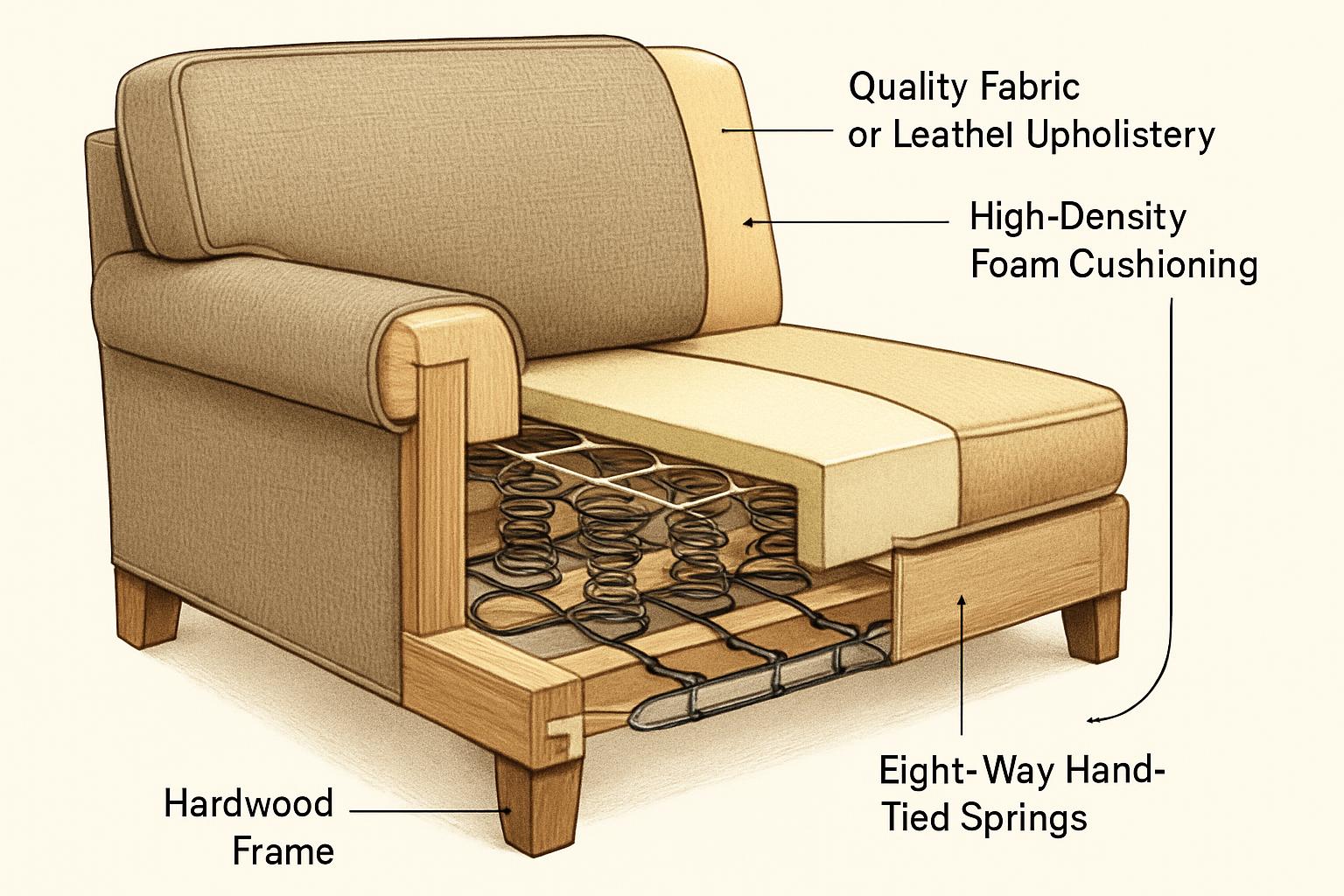
The structural foundation of any sofa lies in its frame construction, which determines not only the piece’s longevity and durability but also its stability, comfort consistency, and overall value proposition. Understanding frame construction principles and quality indicators enables you to assess the long-term value of different options and make informed decisions that balance initial cost with expected lifespan and performance.
Hardwood frame construction represents the gold standard for sofa durability, with kiln-dried hardwoods like oak, maple, and birch providing excellent strength, stability, and resistance to warping or cracking over time. Kiln-drying removes moisture that could cause dimensional changes, ensuring that joints remain tight and the frame maintains its structural integrity throughout years of use. Quality hardwood frames often feature mortise and tenon joinery or other traditional woodworking techniques that create strong, lasting connections between frame components.
Engineered wood products including plywood and laminated lumber can provide good structural performance when properly designed and manufactured, often at lower costs than solid hardwood construction. High-quality plywood frames use multiple layers of wood veneer with alternating grain directions that create excellent strength and dimensional stability. However, the quality of engineered wood products varies significantly, with lower-grade options potentially offering inferior durability compared to solid wood construction.
Softwood frames using pine or other coniferous woods may be acceptable for lighter-duty applications but generally provide inferior durability and strength compared to hardwood alternatives. Softwood frames are more susceptible to denting, splitting, and joint failure, particularly in high-stress areas like arm attachments and corner joints. While softwood construction can reduce costs, it often represents a false economy for furniture intended for regular use over many years.
Metal frame construction, typically using steel tubing or angle iron, can provide excellent strength and durability while allowing for different design approaches than wood construction. Metal frames resist warping and dimensional changes while providing consistent support characteristics over time. However, metal construction requires different joinery techniques and may not provide the same traditional furniture feel that many people prefer in upholstered seating.
Joint construction methods significantly affect frame durability and longevity, with traditional woodworking joints like mortise and tenon, dowel joints, and dovetails providing superior strength compared to simple butt joints held with screws or staples. Corner blocks, which are triangular reinforcements installed at frame corners, add significant strength and help prevent joint failure under stress. Quality frame construction often includes multiple reinforcement methods to ensure long-term structural integrity.
Spring systems provide the foundation for seat comfort and support, with different spring types offering varying characteristics in terms of comfort, durability, and cost. Eight-way hand-tied springs represent the premium option, with individual coil springs tied together with strong cord in eight directions to create a unified support system that provides excellent comfort and durability. This traditional construction method requires skilled craftsmanship but creates seating that maintains its comfort characteristics for decades.
Sinuous springs, also called zigzag or S-springs, use continuous wire formed into S-shaped curves that span from front to back of the seat frame. These springs provide good support and durability at lower costs than hand-tied systems while being easier to manufacture consistently. Quality sinuous spring systems use heavy-gauge wire and proper spacing to provide adequate support, though they may not offer the same longevity as hand-tied alternatives.
Webbing support systems use interwoven strips of strong fabric or elastic material to provide seat support, often in combination with foam cushioning. Quality webbing systems can provide adequate support for lighter-duty applications, though they may not offer the same durability or comfort characteristics as spring systems. The quality and spacing of webbing significantly affects performance, with closer spacing and heavier materials providing better support.
No-sag springs combine aspects of both coil and sinuous spring systems, using individual coils connected by wire links to create support systems that provide good comfort and durability. These systems offer easier manufacturing than hand-tied springs while providing better support characteristics than simple webbing systems, making them popular choices for mid-range furniture.
Frame reinforcement details including corner blocks, center supports, and cross-bracing significantly affect structural integrity and longevity. Quality frames include reinforcements at all stress points and use appropriate fasteners and adhesives to ensure lasting connections. The presence and quality of these reinforcement details often distinguish well-built furniture from budget alternatives that may look similar initially but fail prematurely under normal use.
Size and Scale Considerations for Your Space
Selecting the appropriate size and scale for your sofa requires careful consideration of both your room dimensions and your lifestyle needs, as a sofa that’s too large can overwhelm a space while one that’s too small may not provide adequate seating or visual presence. Understanding how to measure your space, evaluate traffic flow, and balance seating capacity with room proportions ensures that your sofa choice will work well both functionally and aesthetically.
Room measurement and space planning begin with accurate measurements of your room dimensions, including length, width, and ceiling height, as well as the locations of doors, windows, built-in features, and other furniture pieces that will share the space. These measurements provide the foundation for determining what size sofa will fit comfortably while leaving adequate space for traffic flow and other necessary functions. Creating a scaled floor plan, either on paper or using design software, helps visualize how different sofa sizes will work in your specific space.
Traffic flow considerations require ensuring that your sofa placement allows for comfortable movement through the room while maintaining clear pathways to doors, windows, and other seating areas. Standard recommendations suggest maintaining at least 30 inches of clear space for major traffic paths and 18 inches for secondary pathways, though these dimensions may need adjustment based on your specific room layout and usage patterns. Understanding how people will move through your space helps determine both sofa size and optimal placement.
Seating capacity needs depend on your household size, entertaining patterns, and lifestyle preferences, with some families preferring larger sofas that accommodate multiple people while others prioritize space efficiency and choose smaller pieces supplemented with additional seating options. Consider both your daily seating needs and occasional requirements for entertaining or family gatherings when determining appropriate seating capacity.
Proportional relationships between your sofa and other room elements significantly affect the overall visual balance and harmony of your space. A sofa that’s appropriately sized for the room’s square footage but disproportionate to ceiling height, window size, or other furniture pieces can create visual discord that makes the entire room feel uncomfortable. Understanding these proportional relationships helps ensure that your sofa choice enhances rather than detracts from your room’s overall design.
Standard sofa sizes provide general guidelines for different seating capacities and space requirements, though actual dimensions vary significantly between manufacturers and styles. Loveseats typically measure 48 to 72 inches in length and seat two people comfortably, making them suitable for smaller spaces or as supplementary seating in larger rooms. Standard sofas range from about 72 to 96 inches in length and typically seat three people, while larger sofas and sectionals can extend well beyond 100 inches and accommodate four or more people.
Depth considerations affect both the space required for your sofa and the comfort characteristics for different users. Standard sofa depths range from about 32 to 40 inches, including the back cushions, with deeper options available for those who prefer more relaxed seating positions. However, deeper sofas require more floor space and may not work well in smaller rooms or for people who prefer more upright seating positions.
Height considerations include both the overall height of the sofa and the specific heights of the seat, arms, and back, all of which affect both comfort and visual impact. Seat heights typically range from 16 to 20 inches, with lower seats creating more casual, relaxed seating while higher seats make entry and exit easier, particularly for older adults or those with mobility limitations. Back and arm heights affect both comfort and the visual weight of the piece in your room.
Sectional sizing requires additional considerations due to their modular nature and larger overall footprints. L-shaped sectionals need adequate corner space and clearance for both legs of the configuration, while U-shaped sectionals require substantial room dimensions to avoid overwhelming the space. The ability to separate sectional components can provide flexibility for different arrangements or future moves, making modular designs appealing for many situations.
Scale relationships with existing furniture require considering how your new sofa will work with coffee tables, end tables, entertainment centers, and other pieces in your room. Coffee tables should typically be within 12 to 18 inches of the sofa and about the same height as the seat cushions, while end tables work best when they’re close to arm height for convenient use. Understanding these relationships helps ensure that your sofa choice will work well with your existing furniture or guides decisions about what additional pieces you may need.
Style Integration with Your Home’s Aesthetic
Successfully integrating a new sofa into your home’s existing aesthetic requires understanding how different design elements work together to create cohesive, harmonious environments that reflect your personal style while maintaining visual flow throughout your living spaces. The sofa’s style, color, and proportions should complement rather than compete with your existing decor, architectural features, and overall design direction.
Architectural style considerations begin with understanding your home’s fundamental design character, whether it’s traditional, contemporary, transitional, or represents a specific historical period or regional style. Homes with strong architectural character often work best with sofas that complement rather than contrast with these features, while more neutral architectural backgrounds provide greater flexibility for furniture style choices. Understanding your home’s architectural language helps guide sofa selection toward options that will feel integrated rather than imposed.
Color coordination involves more than simply matching existing colors, requiring understanding of how different hues, saturations, and values work together to create pleasing color relationships. Monochromatic schemes using different shades of the same color family create sophisticated, cohesive looks while allowing for subtle variation and interest. Complementary color schemes use colors opposite each other on the color wheel to create dynamic, energetic relationships, while analogous schemes use adjacent colors for harmonious, peaceful effects.
Pattern integration requires careful consideration of scale, style, and visual weight to avoid creating chaotic or overwhelming environments. If your room already includes patterned elements like rugs, window treatments, or wallpaper, your sofa choice should either complement these patterns or provide a solid color foundation that allows existing patterns to shine. The scale of patterns should vary throughout the room, with larger patterns balanced by smaller ones and solid colors providing visual rest areas.
Texture relationships add depth and interest to room designs while affecting both visual and tactile experiences. Smooth leather sofas work well with rough textures like natural wood, woven baskets, or stone surfaces, while textured fabric sofas can complement smooth surfaces like glass, metal, or polished wood. Understanding how different textures interact helps create rooms that feel rich and layered rather than flat or monotonous.
Style mixing can create interesting, personalized environments when done thoughtfully, combining elements from different design periods or approaches to create unique, eclectic looks. Successful style mixing requires understanding the common elements that can tie different styles together, such as color, scale, or material relationships. However, style mixing requires more sophisticated design understanding than staying within a single style category, making it important to proceed carefully if you’re not confident in your design skills.
Focal point considerations determine whether your sofa should serve as the room’s primary visual focus or support other dominant elements like artwork, architectural features, or entertainment centers. Sofas with bold colors, distinctive patterns, or unusual shapes naturally draw attention and work well as focal points, while more neutral options provide comfortable foundations that allow other elements to take center stage.
Lifestyle integration ensures that your sofa choice supports your daily activities and usage patterns while maintaining the aesthetic qualities you desire. Families with young children or pets may need to prioritize durability and easy maintenance over purely aesthetic considerations, while formal living rooms used primarily for entertaining can emphasize style and sophistication. Understanding how you actually use your living spaces helps balance aesthetic and practical considerations.
Future flexibility considerations recognize that design preferences and lifestyle needs change over time, making it wise to choose sofas that can adapt to different decorating approaches or room configurations. Neutral colors and classic styles typically offer more flexibility for future changes, while bold or trendy choices may become dated or limiting as tastes evolve. Understanding your own design evolution patterns helps determine whether to choose safe, flexible options or more distinctive pieces that reflect current preferences.
Maintenance and Care Requirements
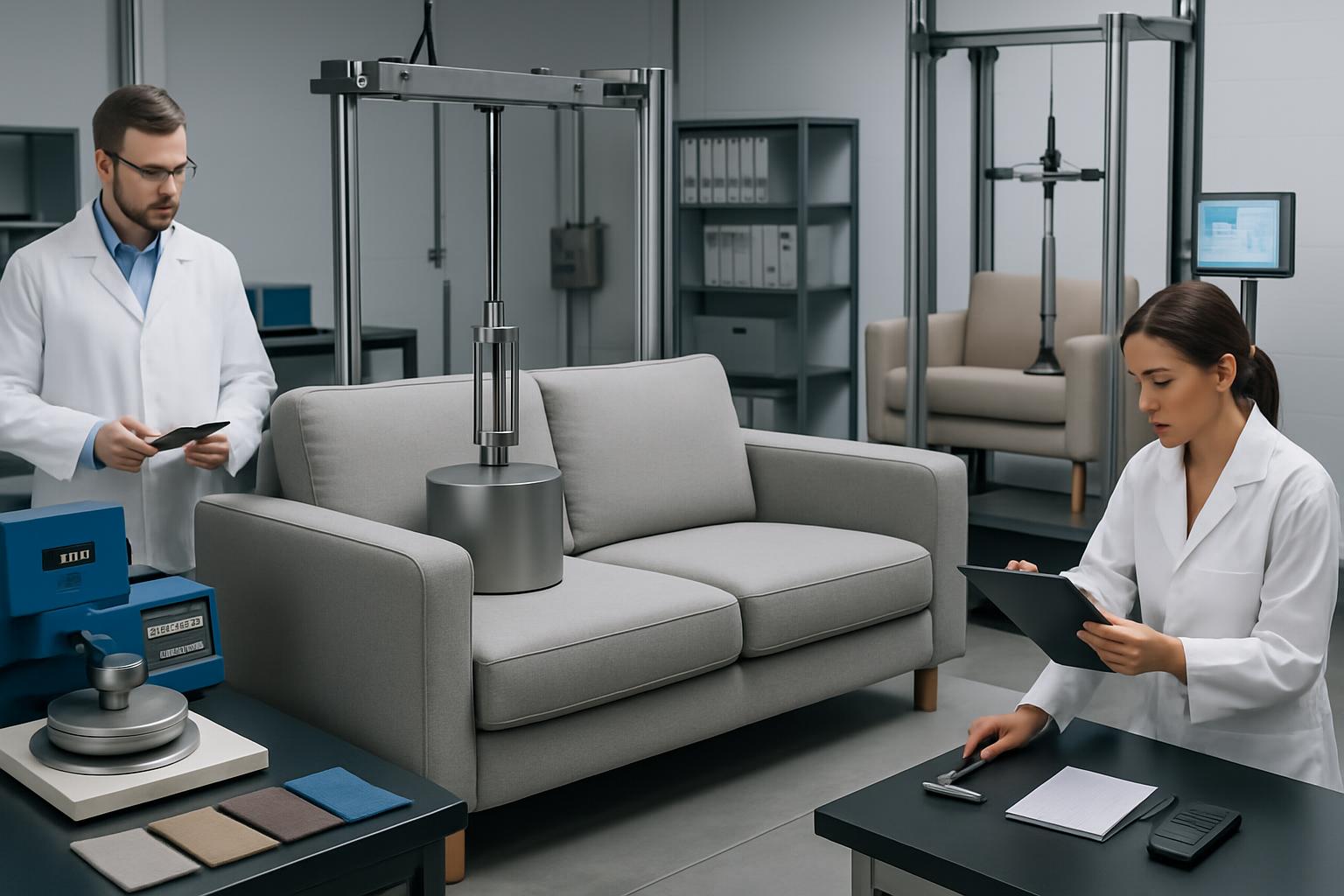
Understanding the maintenance and care requirements for different sofa materials and construction types enables you to make informed decisions about which options align with your lifestyle and maintenance preferences while ensuring that your investment maintains its appearance and performance throughout its intended lifespan. Different materials and construction methods require varying levels of care, from simple routine maintenance to more intensive periodic treatments.
Fabric care requirements vary significantly depending on the fiber content, weave structure, and any protective treatments applied during manufacturing. Natural fiber fabrics like cotton and linen typically require more careful maintenance than synthetic alternatives, with considerations for shrinkage, color bleeding, and fiber damage from harsh cleaning products. Understanding the specific care requirements for your chosen fabric helps prevent damage and maintains appearance over time.
Professional cleaning recommendations for fabric sofas typically suggest annual or bi-annual professional cleaning to remove deep-seated dirt, oils, and odors that regular vacuuming cannot address. Professional cleaners have access to specialized equipment and cleaning solutions that can safely clean delicate fabrics while removing stains and refreshing appearance. However, professional cleaning costs should be factored into the total cost of ownership when comparing different upholstery options.
Spot cleaning techniques for fabric sofas require understanding which cleaning products and methods are safe for your specific fabric type, as inappropriate cleaning can cause permanent damage, color changes, or fabric deterioration. Many manufacturers provide specific cleaning codes that indicate appropriate cleaning methods, from water-based cleaning to solvent-only cleaning or professional cleaning only. Understanding these codes and having appropriate cleaning supplies readily available helps address spills and stains before they become permanent.
Leather care involves different considerations and techniques than fabric maintenance, requiring specific products and methods to maintain the leather’s appearance, suppleness, and durability. Regular cleaning with appropriate leather cleaners removes dirt and oils that can cause deterioration, while conditioning treatments help maintain the leather’s natural oils and prevent cracking or hardening. Understanding proper leather care techniques helps ensure that leather sofas develop attractive patina rather than showing premature wear.
Preventive maintenance for all sofa types includes regular vacuuming to remove dirt and debris that can cause abrasive wear, rotating and flipping cushions to ensure even wear patterns, and protecting the sofa from direct sunlight that can cause fading or material deterioration. Simple preventive measures can significantly extend the life and appearance of your sofa while reducing the need for more intensive maintenance or repairs.
Environmental factors affecting sofa maintenance include humidity levels, temperature variations, air quality, and exposure to sunlight, all of which can affect both fabric and leather performance over time. Understanding how your home’s environment affects different materials helps you choose options that will perform well in your specific conditions while taking appropriate protective measures to minimize environmental damage.
Pet and child considerations require understanding how different materials and construction types respond to the specific challenges these family members present. Some fabrics and leathers are more resistant to scratching, staining, or odor absorption, while certain construction types may be more durable under intensive use. Understanding these factors helps choose sofas that will maintain their appearance and function despite the additional wear that pets and children typically create.
Warranty and protection plan considerations provide additional security for your investment while potentially reducing long-term maintenance costs. Understanding what different warranties cover, their duration, and any maintenance requirements for warranty validity helps you make informed decisions about extended protection. Some retailers offer protection plans that cover staining, wear, or damage beyond standard manufacturer warranties, though the value of these plans depends on their specific terms and your usage patterns.
Repair and restoration options for different sofa types affect their long-term value and sustainability, with some construction types and materials being more easily repaired or restored than others. Quality frame construction typically allows for reupholstering when fabric or leather shows wear, potentially extending the sofa’s life significantly. Understanding repair options and costs helps evaluate the long-term value proposition of different choices while supporting sustainable consumption practices.
Budget Considerations and Value Assessment
Establishing an appropriate budget for sofa purchases requires understanding the relationship between initial cost, expected lifespan, and ongoing maintenance expenses to determine the true cost of ownership for different options. Quality sofas represent significant investments that should be evaluated based on their long-term value rather than simply their initial purchase price, as higher-quality pieces often provide better value over their extended lifespans.
Price range understanding helps set realistic expectations for what features and quality levels are available at different budget points, from basic budget options that provide functional seating to luxury pieces that offer premium materials, construction, and design. Entry-level sofas typically range from several hundred to around two thousand dollars and may offer adequate function for light use or temporary situations, while mid-range options from two to five thousand dollars often provide good balances of quality, style, and durability for most households.
Premium and luxury sofas extending from five thousand dollars to well beyond ten thousand dollars typically offer superior materials, construction quality, and design sophistication that justify their higher costs for buyers who prioritize quality, longevity, or specific aesthetic requirements. Understanding what differentiates these price categories helps determine which level provides the best value for your specific needs and preferences.
Cost per year calculations provide useful perspectives on sofa value by dividing the initial cost by the expected lifespan to determine annual ownership costs. A higher-quality sofa that costs more initially but lasts significantly longer may provide better value than cheaper alternatives that require replacement more frequently. These calculations should also consider maintenance costs, as some materials or construction types may require more expensive care over their lifespans.
Quality indicators that affect value include frame construction materials and methods, spring systems, cushion quality, upholstery materials, and overall craftsmanship details. Understanding how to identify these quality markers helps evaluate whether higher prices reflect genuine quality improvements or simply brand premiums or marketing positioning. Learning to assess construction quality enables more informed value comparisons between different options.
Timing considerations for sofa purchases can significantly affect costs, with seasonal sales, floor model clearances, and end-of-line promotions offering opportunities for substantial savings on quality pieces. Understanding furniture retail cycles and sale patterns helps time purchases to maximize value while ensuring adequate selection of desired styles and features. However, timing purchases around sales requires flexibility in style and delivery timing that may not work for all situations.
Financing options offered by many furniture retailers can make higher-quality sofas more accessible by spreading costs over time, though the terms and interest rates of these arrangements significantly affect their value. Understanding the true cost of financing, including interest charges and fees, helps determine whether financing arrangements provide genuine value or simply make expensive purchases seem more affordable while increasing total costs.
Used and vintage options can provide access to higher-quality construction and materials at reduced costs, though they require more careful evaluation of condition, remaining lifespan, and potential restoration costs. Quality vintage sofas often feature superior construction methods and materials that are no longer commonly available, making them potentially excellent values for buyers willing to invest in restoration or who appreciate their existing character.
Custom and semi-custom options allow for precise specification of materials, dimensions, and features while often providing better value than comparable ready-made pieces. Understanding the costs and timelines associated with custom work helps determine when this approach provides better value than selecting from available inventory. Custom work also allows for optimization of size, style, and materials for specific needs that may not be available in standard offerings.
Investment perspective considerations recognize that quality sofas can provide decades of service while maintaining significant value, making them more like investments in home infrastructure than simple purchases. Understanding depreciation patterns, resale values, and the potential for restoration helps evaluate the long-term financial implications of different choices while supporting more sustainable consumption patterns that prioritize quality and longevity over frequent replacement.
Frequently Asked Questions
How long should a quality sofa last?
A well-constructed sofa with a hardwood frame, quality springs, and good upholstery should last 15-25 years with proper care. Budget sofas may last 5-10 years, while premium pieces can serve for decades. The frame construction and spring system are the most important factors in longevity, as these are expensive to repair or replace.
What’s the difference between a 1,000sofaanda1,000 sofa and a 1,000sofaanda5,000 sofa?
The main differences typically include frame construction (hardwood vs. softwood or engineered wood), spring systems (hand-tied vs. sinuous springs), cushion quality (down vs. foam), upholstery materials (premium fabrics/leather vs. basic options), and overall craftsmanship. Higher-priced sofas generally offer better durability, comfort, and materials that justify the cost difference over their longer lifespans.
Should I choose fabric or leather for a family with young children?
Both can work well depending on the specific materials chosen. Performance fabrics with stain-resistant treatments are excellent for families, as they’re easy to clean and maintain. Quality leather is also very durable and wipes clean easily, though it can be scratched by sharp objects. Avoid delicate fabrics like silk or light-colored materials that show stains easily.
How do I know if a sofa frame is well-constructed?
Look for kiln-dried hardwood frames, preferably with mortise-and-tenon or dowel joints rather than just screws or staples. The frame should feel solid without wobbling, and you should be able to lift one end of the sofa by a leg without the frame flexing. Ask about corner blocks and reinforcements, and check if the manufacturer offers a frame warranty.
What’s the best cushion filling for comfort and durability?
High-density foam provides the best balance of comfort, support, and durability for most people. Down is luxuriously soft but requires maintenance and may not provide adequate support. Memory foam offers excellent support but can feel warm and slow to respond. Spring-down combinations provide both support and softness but are more expensive.
How much space should I leave around my sofa?
Leave at least 30 inches for main traffic paths and 18 inches for secondary walkways. The coffee table should be 12-18 inches from the sofa and roughly the same height as the seat cushions. End tables work best when they’re close to arm height for convenient use.
Can I reupholster my sofa instead of buying new?
If the frame and springs are in good condition, reupholstering can be cost-effective and environmentally friendly. However, reupholstering typically costs 50-70% of a new sofa’s price, so it’s most worthwhile for high-quality frames or pieces with sentimental value. Get quotes from professional upholsterers before deciding.
What’s the best way to clean different sofa materials?
Check the manufacturer’s cleaning code first. “W” means water-based cleaners, “S” means solvent-based only, “WS” means either is acceptable, and “X” means professional cleaning only. For leather, use products specifically designed for leather and condition regularly. Always test cleaning products in an inconspicuous area first.
How do I choose the right size sofa for my room?
Measure your room carefully and create a floor plan. The sofa should be proportional to the room size – typically no more than two-thirds of the wall length. Consider traffic flow, door clearances, and how the sofa will work with other furniture. When in doubt, slightly smaller is usually better than too large.
Are sectional sofas a good choice for small spaces?
Measure your room carefully and create a floor plan. The sofa should be proportional to the room size – typically no more than two-thirds of the wall length. Consider traffic flow, door clearances, and how the sofa will work with other furniture. When in doubt, slightly smaller is usually better than too large.
What should I look for when buying a sofa online?
Read detailed specifications, customer reviews, and return policies carefully. Look for companies that offer fabric samples, detailed construction information, and generous return periods. Check shipping costs and delivery timelines. If possible, visit showrooms to feel similar models in person before ordering online.
How important is the sofa’s country of origin?
Country of origin can indicate quality levels and manufacturing standards, but it’s not the only factor. Some countries have strong furniture-making traditions and quality control, while others focus on cost efficiency. More important is the specific manufacturer’s reputation, construction details, and warranty terms regardless of where it’s made.





